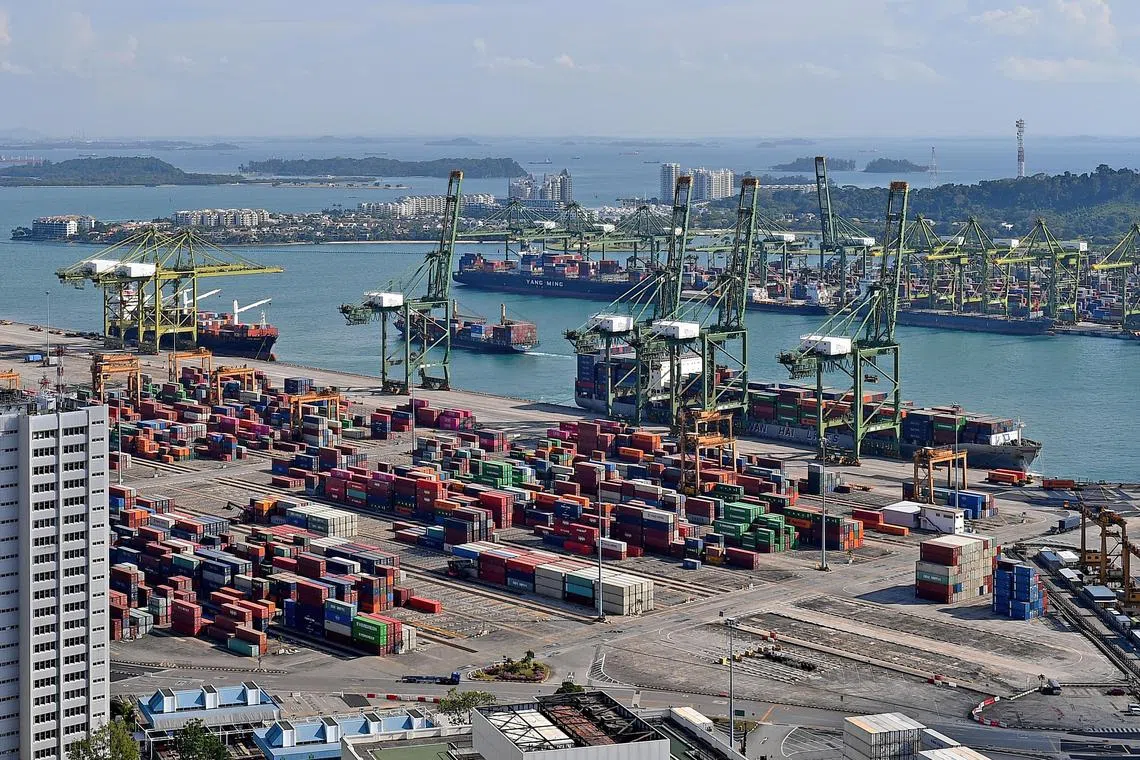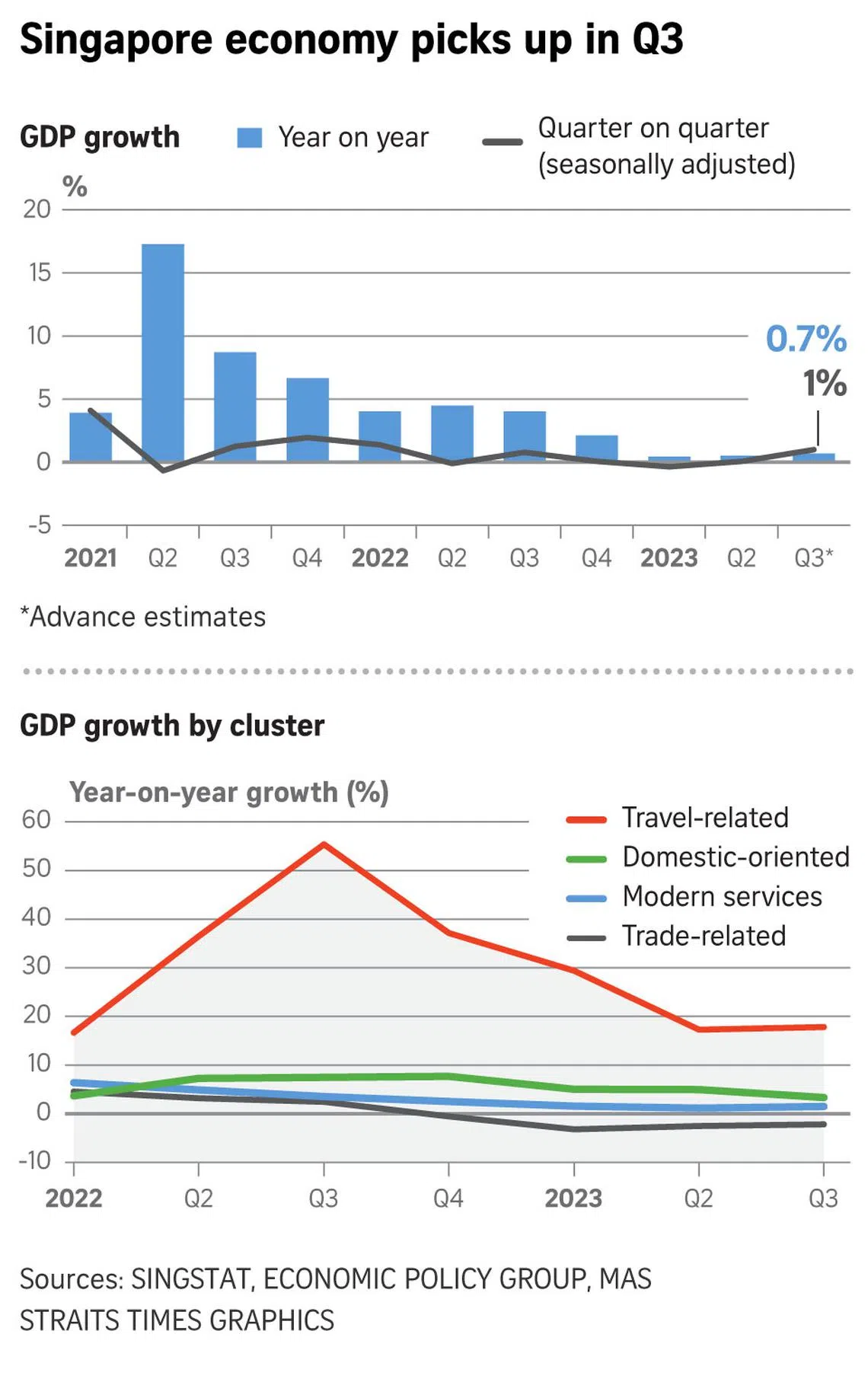Singapore’s economic growth to pick up pace in 2024, inflation to ease after GST-driven rise: MAS
Sign up now: Get ST's newsletters delivered to your inbox

MAS said growth should speed up as demand for Singapore’s exports recover and interest rates cease their surge globally.
PHOTO: ST FILE
Follow topic:
SINGAPORE – Singapore’s economy is expected to shake off the stagnation it has suffered for most of 2023 and grow at a faster pace in 2024.
Inflation will also ease, though not without a temporary rise, partly due to the upcoming hike in the goods and services tax (GST),
The Monetary Authority of Singapore (MAS) said growth should speed up – after coming in at the lower half of the 0.5 per cent to 1.5 per cent forecast range in 2023 – as global demand for Singapore’s exports recover and interest rates cease their surge globally, helping the financial sector here.
“GDP (gross domestic product) growth is expected to improve gradually in the second half of 2024, and come in closer to its potential rate for the full year,” it said in its biannual macroeconomic review report.
MAS did not put a number to that potential growth rate – usually defined as the pace of growth that an economy can sustain over the medium term without generating excess inflation.
However, most analysts believe it to be around 2 per cent to 3 per cent.
Singapore’s export-led manufacturing sector has been in the doldrums since October 2022
Non-oil domestic exports have shrunk through the same period.
Higher global interest rates that made loans more expensive weighed down the Republic’s financial sector growth as well.
The economy avoided an outright recession as the domestic-oriented services sector and travel-related industries offset the slump in manufacturing and the weaker financial sector with their above-trend growth after the end of Covid-19 curbs, the central bank said.
Now, however, there are nascent signs of a pickup in the electronics industry
MAS noted that electronics exports from Taiwan – the global bellwether of the tech industry – have returned to growth.
Tech exports from Singapore and South Korea have also bottomed out, though they remain in contraction territory.
“The Singapore economy should benefit as the global tech industry gradually emerges from its trough and global interest rates level off over 2024,” MAS said.

It believes manufacturing in Singapore should see a cautious recovery, although growth could be lacklustre for an extended period amid lingering uncertainty over the trajectory of the major economies – namely the United States, China and the European Union.
There are also early signs that the financial sector has bottomed out amid stabilising interest rates, paving the way for a modest recovery in 2024, said MAS.
The US Federal Reserve and the European Central Bank, along with many other policymakers worldwide, have put a pause on rate hikes
Meanwhile, the above-trend growth seen in Singapore’s travel-related services and the domestic-oriented sector is expected to normalise towards a lower but steadier pace.
MAS said the Singapore economy stagnated from the fourth quarter of 2022 to the second quarter of 2023, with quarterly sequential growth averaging minus 0.1 per cent seasonally adjusted over this period.
On an annual basis, GDP growth slowed to 0.5 per cent in the first half of 2023 from 2.1 per cent in the fourth quarter.
“The economy has broadly been on a three-speed trajectory,” MAS said.
While the external-facing industries – largely manufacturing and financial – were in the doldrums, their weakness did not spill over to the domestic-facing sectors, which recorded above-trend growth after Covid-19 restrictions were lifted.

Meanwhile, travel-related industries benefited from the reopening of borders, chalking up strong double-digit growth rates.
The third quarter of 2023 may have marked the turning point in the slowdown, MAS said.
Based on advance estimates, overall GDP expanded by 1 per cent quarter on quarter in the third quarter, improving from 0.1 per cent in the previous quarter.
GDP growth also picked up year on year in the July-August period to 0.7 per cent, from 0.5 per cent in the previous quarter.
However, MAS warned: “There is still uncertainty over the strength and sustainability of the pickup in the Singapore economy, which is contingent on that of external final demand.”
Global growth is set to slow further over the coming quarters, led primarily by a retraction in growth of the Group of Three economies – the euro zone, Japan and the US.
Growth in the global economy is projected to reach 3.1 per cent in 2023 as a whole, and slow to 2.8 per cent in 2024, according to MAS estimates.
The US and euro zone are expected to experience a period of below-trend growth, as the lagged impact of tighter monetary policy and diminishing saving buffers increasingly weigh on economic activity and spending, said MAS.
Meanwhile, China’s economy, which has witnessed some signs of improvement lately, continues to face headwinds from the structural challenges facing its property market.
Hence, broader recovery in goods trade is likely to remain constrained, given China’s relatively subdued outlook, and the projected downturn in US and euro zone manufacturing and business investment over the coming quarters.
“The global macroeconomic outlook faces several downside risks, including a sharper China slowdown, stubborn inflation and tighter financial conditions,” MAS said.
MAS reiterated that for 2024 as a whole, Singapore’s core inflation, which excludes accommodation and private transport costs, will slow to an average of 2.5 per cent to 3.5 per cent.
All-items headline inflation is forecast to reach around 3 per cent to 4 per cent, after 2023 closes with core inflation averaging at around 4 per cent and headline inflation at 5 per cent.
MAS said core inflation, which is a better gauge of price increases most Singapore households face, is expected to edge up in the first quarter of 2024, reflecting the GST hike due on Jan 1, as well as increases in the costs of water, electricity and public transport.
However, MAS estimates that core inflation should thereafter resume its broad moderating trend.
Upside risks to inflation remain, including from additional shocks to global food and energy commodity prices, and stronger than expected wage pressures, MAS said.
Conversely, an unexpectedly sharp deceleration in global economic growth could also lead to more rapid than expected deceleration in inflation, it added.


